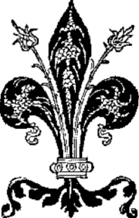A rebirth of knowledge
What we are accustomed to call the Renaissance began as a rediscovery of older knowledge, and flowered as a series of new discoveries and new attitudes.
In the particular alchemy of the social and political climate of Florence* in the late fourteenth century, humanism was born: scholars and administrators read the Latin of Vergil and Cicero, and explored Greek writers for the first time in centuries. Contact with earlier ways of seeing the world encouraged a new exploration of ideas, of art, and of the physical universe.
From Florence the movement of minds widened to include the whole of Italy, spreading through France, and finally reaching England about a century later.
From the literal to the symbolic
A movement as complex as the Renaissance cannot be summed up in a sentence or two; but there was one fundamental change in the way humans looked at the world: from a belief in the literal interconnectedness of all things-- correspondences that dictated when a physician should administer a medicine according to the position of the planets, for example--writers and thinkers questioned the connections, while retaining a sense of their beauty as symbols. Thus Falstaff, skeptic and cynic, parodies the earlier literal belief in the human body as a reflection and representation of the state in a comic attack on John of Lancaster's seriousness.
Footnotes
-
Names of the Italian Renaissance
Even a modest exploration of the Italian Renaissance would take a siteCD-ROM at least as big as this one on Shakespeare. The roll-call of notable Italian renaissance figures is formidable: The Medicis, Petrarch, Botticelli, Ghiberti, Donatello, Michaelangelo, Leonardo da Vinci, Raphael, Ficino, Pico della Mirandola, Savonarola, Machiavelli, Castiglione, Tasso, Ariosto, Alberti . . .
